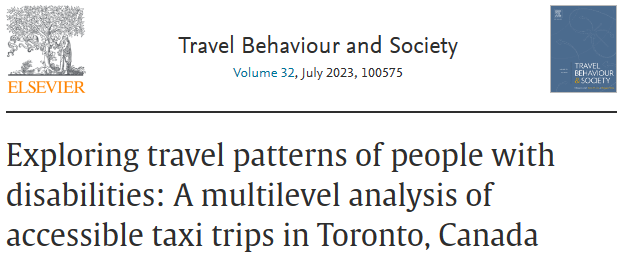Yixue Zhang, Steven Farber, Mischa Young, Ignacio Tiznado-Aitken, Timothy Ross
Abstract
Improving transport accessibility for people with disabilities (PWD) is crucial, given that this group is more likely to encounter transport-related exclusion (Lucas, 2012). Previous studies have shown that PWD experience numerous difficulties when travelling by public/para-transit (Bezyak et al., 2017; Park et al., 2022). If public transit services and policies are not improved to remove barriers for PWD, they will continue to experience limited access.
Although PWD experience public transport-related inequities and exclusions, little is known about their travel patterns, possibly because their presence and diversity are often overlooked in transport research and travel surveys, and by planning practitioners (Oliver, 2013).
This study investigates how PWD use accessible taxis in Toronto, Canada. Using spatial–temporal analyses and a multilevel regression model, we engage three research questions: (1) When and where are accessible taxi trips occurring in Toronto? (2) What are the primary trip purposes? And, (3) what factors influence the wait and in-vehicle times? Study data comes from a fully accessible taxi brokerage. The dataset includes roughly-one million accessible taxi trips from June 2018 to June 2021.
The results show that the primary trip purpose of PWD is home-based health-related service i.e., the riders are travelling from home to health services or vice versa. Temporal aspects of trips (i.e., departure time, day of the week, and season) influence wait and in-vehicle times. Neighbourhood-level factors, such as population density, health service density, and rate of visible minorities have significant effects on in-vehicle times.
These findings contribute to current academic debates on accessibility, equity, and inclusion issues as they relate to disability. Findings may also affect the lives of PWD by informing their advocacy efforts and helping accessible taxi service providers advance much-needed policy dialogue and service improvements.
